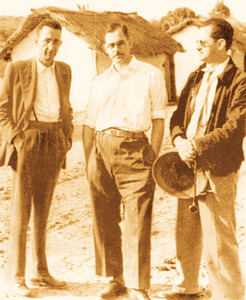
personal file of jcpd
Dias auscultating woman in Bambuí (1945): barber bug infested 80% of the housespersonal file of jcpdIn 1940, a patient with the characteristic symptom of Chagas Disease – a swelling of one of the eyes, referred to as Romaña’s sign – led Amílcar Martins, a researcher at the Instituto Ezequiel Dias, in the city of Belo Horizonte, to travel to Bambuí, in the western region of the state of Minas Gerais. When Martins arrived there, he realized that he was in the center of a highly endemic region of the disease; he informed Emmanuel Dias and Cecílio Romaña, from the Instituto Oswaldo Cruz/IOC), in the city of Rio de Janeiro, about this and the two researchers traveled to Bambui. The town is located close to the spring of the São Francisco River. This is where the earliest experiments were conducted which later led to the successful eradication of Chagas Disease in Brazil. Emmanuel Dias (1908-1962) was the main character in this second phase of the discovery of how this disease is transmitted.
Carlos Chagas astonished everyone when in April 1909 he announced to the scientific community that he had discovered an unknown human disease, the agent of the disease (the Trypanosoma cruzi protozoa) and the insect vector (the triatomine bug, also known as the barber bug). This was a unique situation in the history of Brazilian medicine, because the same scientist had been able to identify the three factors. The disease often leads to death because of serious chronic heart disease provoked by the T. cruzi.

personal file of jcpd
Renovated railway…personal file of jcpdOnly 29 acute cases had been identified from the time Chagas started his research studies in 1908, until 1940; all of these cases had been identified in the north of the State of Minas Gerais. When the epidemic affected the town of Bambuí, Emmanuel Dias was appointed to carry on research studies in that town, where he identified 80% of the houses infested with the barber bugs – half of the population living on the outskirts of the town was infected. In 1943, Dias set up the Center for Studies and Prophylaxis of Chagas Disease in the town, which was connected to the IOC (currently named Fiocruz). Dias mapped the region and started an unstoppable battle to eliminate the insect. There was no vaccine or efficient treatment for the disease – and this still holds true today. Dias identified 368 acute cases and approximately 10 thousand chronic cases of the disease.

personal file of jcpd
…and houses: Dias convinced the executives of the railway company to renovatepersonal file of jcpdThe railway and immigration brought the barber bug to Bambuí. Once it reached the region, the bug found the perfect conditions to procreate: the houses were very poor, built from wood or wattle and daub. Dias knew that the only chance to stop the transmission of the disease was to eliminate the insect vector. To this end, he tried all the known methods – ranging from cyanide gas flame throwers to caustic soda and kerosene compounds. “He even purchased barber bugs, but there were so many of them that he ran out of money,” he said.

personal file of jcpd
Researchers Valdemar Versiani (left), Amílcar Martins and Dias in front of renovated huts, in 1946personal file of jcpdJoão Carlos Pinto Dias, is one of the five children of Emmanuel. He works as a researcher at the Centro de Pesquisas René Rachou research center in Belo Horizonte, and is a director of the center established by his father. The best results were obtained by using BHC, an insecticide that was banned some years later. Dias visited schools, wrote articles, brought federal government authorities to visit the town infested with the barber bugs. He was able to improve some houses, such as the homes owned by railway workers employed by the former Rede Mineira de Viação Railway. He did so by building brick houses for these workers and by whitewashing them. These were the earliest campaigns to eradicate the disease. The researcher himself extended these campaigns all over Brazil and then to Chile, Uruguay, Venezuela, Costa Rica and Argentina, until his death in a car accident in 1962. “Nowadays, infestation in Bambuí is non-existent,” reports João Carlos. In 2006, the Pan American Health Organization (PAHO) certified the country as being barber bug-free. In August 2008, Paulo Buss, the president of Fiocruz, paid homage to Emmanuel Dias at public ceremony, by naming Dias as the scientist with the biggest impact on the eradication of this disease.
Republish